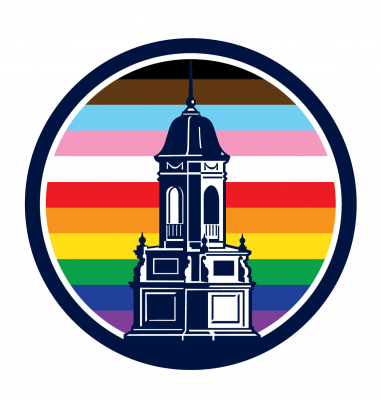
1. Tell us a bit about the project you are working on at UCHI.
I’m working on a history of college radio since the 1960s. While on first glance this might seem like a straightforward topic, it actually is quite complex. Historians of radio and media have demonstrated how the interplay of regulation, technology, commercial interests, and cultural producers created a complex and shifting landscape for radio broadcasting—which has only grown more interesting with the rise of the internet and music streaming. My archival research focuses on the development of a distinctive culture and reputation of college radio, beginning in the shift towards FM and free-form programming in the 1960s and maturing by the mid-1980s. This culture of college radio, which stands out from the broad swath of college radio history in its myriad incarnations, had significant influence on the music industry and popular music. My goal is to both complicate and broaden that definition — which tends to focus on the genre of “indie” or “alternative” rock — to include a wider perspective of genres and communities. Ultimately, my goal is to reveal how shifting regulation, university goals, and the politics of the culture wars shaped the culture of college radio at the end of the 20th century.
2. What drew you to this topic and what exciting developments are you anticipating?
When I arrived as a freshman at Vanderbilt University in 1997, the first quiz of my college career was not for PoliSci 101 or Inorganic Chemistry: it was on the 7 words I couldn’t say on the radio. I stumbled into college radio at a student activities fair, not really having any idea what it was or what it meant. I was from rural Vermont, and my only exposure to college radio was the commercial Dartmouth station, which had a mostly classic rock format. Little did I know that I was entering college radio at the height of its reputation and modern identity. As a student I witnessed the debut and demise of Napster, and came to appreciate the potential revolution of the digital disruption. A decade after I graduated, Vanderbilt sold its station’s signal, and the station, once a reputed broadcaster in college radio, now exists only online. My experience might suggest that my book project would promote a kind of declension narrative of college radio, arguing that technological disruptions displaced and destroyed the culture of college broadcasting that I trace in my archival research. Instead, my research explores the continually contested nature of that identity, as well as its diversity and complexity. Throughout college radio’s history, it expanded and narrowed its coverage of artists and musical sounds based on many factors from local to national. Universities sought to use stations as community outreach avenues; students sought the airwaves for personal expression; community and activist groups looked to educational stations for quality programming and representation not available on commercial stations. Musicians accessed networks of college students to expand their exposure and to facilitate touring. Each station had a unique relationship with its host institution, student body, and community and related businesses such as record stores, concert venues, and publications. My goal for this project is to dig into these relationships and explore how the national reputation of college radio emerged and declined, and to correlate that reputation to the actual diversity and perseverance of college radio.
3. What are you looking forward to in regard to this year at UCHI?
As I finish my archival research at stations across the country, I’m looking forward to my time at UCHI to put together what I have learned into an engaging and coherent narrative. The research for this project has been exciting. I’ve found so many interesting stories and people, from pioneering community deejays, to fights between students and administrators over station control, to offended listeners who find objectionable content from stations and take their complaints to the FCC. This year will be dedicated to making sense of these stories and to construct an argument that explains the origins, experiences, and role of college radio since the 1960s in a way that does justice to its influence, including its limits, as well as its diversity. My goal is to have a working draft of the manuscript by the end of the year, honed through the conversations and
4. Many people wonder what value the humanities and humanities research has in today’s world. What are your thoughts on what humanities scholarship “brings to table?”
The humanities is about looking beneath the stories we tell about ourselves and others. But humanistic study is about more than unpacking these stories and complicating them. I assert that the humanities have a liberating function.
We often talk about critical thinking as key to humanities’ classrooms. While the term is often vaguely invoked, it’s here where the study of history, of learning based in the humanities, has the power to liberate. For example, the study of history allows us to see what is present and not present in our own lives by experiencing other times and other places. As philosopher John Dewey explained, imagination is not only the pathway to creativity, to create the alternative realities explored in poetry and art, but it places imagination at the center of morality, at the center of empathy, at the center of the learning process — to create what is new, what is better.
The liberating function provided by the study of history and the humanities, receives my favorite illustration from the writer and poet Robert Penn Warren. Willie Stark, Penn’s characters in All the King’s Men, posited a pessimistic view of human nature: “Man is conceived in sin and born in corruption, and he passeth from the stink of the dydie to the stench of the shroud… There’s always something.”
This view of the inescapability of man’s original sin rendered individuals’ actions meaningless. In this view, we might be able to imagine the past, and even use it — in Stark’s case, to smear our political enemies — but it’s the wrong view. Stark’s view of history, and of humanity, is indeed just that: stark. This view contributed to his assistant Jack Burden’s nihilism towards life: to his view that “all the words we speak meant nothing and there was only the pulse in the blood and the twitch of the nerve, like a dead frog’s leg in the experiment when the electric current goes through.” Our lives, our choices, to someone who viewed history and time as a burden, reflected nothing but the Great Twitch — that our actions are the mere electronic responses of our biology.
It is this view of history and information that students often come to college with — seeing a meaningless litany of dates, facts, and figures. Their education becomes yet another reflex, programmed by external forces.
Yet the kinds of questions inherent in humanistic study, in questioning received narratives and representations, endow in students to the power to shape truth, the power to shape life.
Jack Burden made this realization — as he states:
“…all times are one time, and all those dead in the past never lived before our definition gives them life, and out of the shadow their eyes implore us. That is what all of us historical researchers believe. And we love truth.”
Burden, through his own regeneration, through his own embrace of the study of history, came to accept “the awful responsibility of time”—that each present action carries future consequences and that which can, in turn, be traced back to events in the past. Armed with this sense of interconnectedness, Burden was able to finally live, to finally have the courage to face his responsibilities as a human being. In the humanities, we seek to understand truth; we seek it not just for its own sake, but so that we may continue to be active agents in the world around us, shaping our future as historical actors in the past shaped—or failed to shape—theirs.
With information access rising, the critical thinking skills of the humanities become increasingly essential: our students are barraged by information; they need the ability to question, to separate fact from fiction, propaganda from persuasive argument. They need to be able to understand how the statements of others reflect worldviews and experiences different from theirs. With polemicists charging that digital media is dumbing the younger generation, enhancing students’ critical thinking is an increasingly important task. As students of the human condition, we have a responsibility to apply not only our skepticism and our skills, but also our ability to imagine, to enter into the worldview of someone else, and to do so with understanding and compassion.





